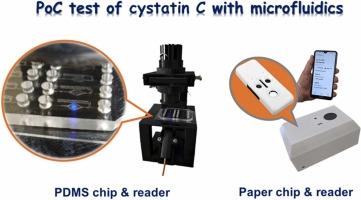Integrated microfluidic immunoassays for point-of-care diagnostic measurement of human serum cystatin C in chronic kidney disease
IF 3.7
1区 化学
Q1 CHEMISTRY, ANALYTICAL
引用次数: 0
Abstract
Cystatin C (CYS-C) is considered superior to creatinine as a serum biomarker of estimated glomerular filtration rate (eGFR) for chronic kidney disease (CKD) assessment. It is minimally influenced by non-filtration-specific factors such as muscle mass, age and gender. However, currently CYS-C testing is limited to specialized diagnostic labs and no point-of-care (PoC) tools are clinically available. To address this gap, we leveraged the enabling power of microfluidic devices for PoC tests of CYS-C. Among the microfluidic devices, PDMS-based wet chips and paper-based dry chips have been widely used for disease biomarker measurements with their respective advantages and limitations. Therefore, in this study, we developed a PDMS-based microfluidic immunoturbidity chip allowing side-scattering optical measurement and a paper-based microfluidic lateral flow immunoassay chip plus a novel electric field-assisted antibody loading protocol for quantitative CYS-C tests. We demonstrated that both chips meet the clinical requirements of the serum CYS-C detection range and limit. Importantly, each type of microfluidic chip is integrated with a custom-developed portable reader as PoC test prototypes. In validation studies using serum samples from CKD patients, both chip tests showed a similar agreement level with the traditional well plate-based immunoturbidity assay test results. As an integrated PoC test system, the microfluidic CYS-C paper chip test showed higher accuracy in determining the eGFR range based on several clinically relevant grouping criteria compared to the turbidity chip test. Collectively, these integrated microfluidic assays offer practical solutions for decentralized PoC diagnostic tests of CKD with competitive advantages over existing methods.

集成微流控免疫分析法用于慢性肾脏疾病患者血清胱抑素C的即时诊断测量
胱抑素C (CYS-C)被认为优于肌酐,是评估慢性肾脏疾病(CKD)肾小球滤过率(eGFR)的血清生物标志物。它受非过滤特异性因素如肌肉质量、年龄和性别的影响最小。然而,目前CYS-C检测仅限于专门的诊断实验室,临床上没有即时护理(PoC)工具。为了解决这一差距,我们利用微流控装置的使能能力进行CYS-C的PoC测试。在微流控器件中,基于pdm的湿芯片和基于纸的干芯片各有优缺点,已广泛应用于疾病生物标志物的测量。因此,在本研究中,我们开发了一种基于pms的微流控免疫浊度芯片,允许侧散射光学测量,以及一种基于纸的微流控侧流免疫分析芯片,以及一种新的电场辅助抗体加载方案,用于定量CYS-C测试。结果表明,两种芯片均满足临床对血清CYS-C检测范围和限限的要求。重要的是,每种类型的微流控芯片都集成了定制开发的便携式读取器作为PoC测试原型。在使用CKD患者血清样本的验证研究中,两种芯片测试都显示出与传统孔板免疫浊度测定结果相似的一致性水平。微流控CYS-C纸屑试验作为一种集成的PoC检测系统,与浊度芯片试验相比,基于几种临床相关的分组标准确定eGFR范围具有更高的准确性。总的来说,这些集成的微流控分析为分散的慢性肾病PoC诊断测试提供了实用的解决方案,与现有方法相比具有竞争优势。
本文章由计算机程序翻译,如有差异,请以英文原文为准。
求助全文
约1分钟内获得全文
求助全文
来源期刊

Sensors and Actuators B: Chemical
工程技术-电化学
CiteScore
14.60
自引率
11.90%
发文量
1776
审稿时长
3.2 months
期刊介绍:
Sensors & Actuators, B: Chemical is an international journal focused on the research and development of chemical transducers. It covers chemical sensors and biosensors, chemical actuators, and analytical microsystems. The journal is interdisciplinary, aiming to publish original works showcasing substantial advancements beyond the current state of the art in these fields, with practical applicability to solving meaningful analytical problems. Review articles are accepted by invitation from an Editor of the journal.
 求助内容:
求助内容: 应助结果提醒方式:
应助结果提醒方式:


